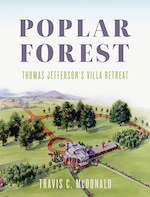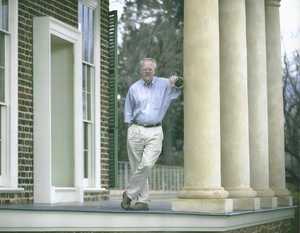Today, we are happy to bring you our conversation with Travis C. McDonald, author of Poplar Forest: Thomas Jefferson's Villa Retreat.
What inspired you to write this book?
I’ve been privileged in my professional career to have spent thirty-four years restoring Jefferson’s most intimate and unknown work of architecture. Over that period I’ve thought about Jefferson as an architect and builder, and what Poplar Forest means, almost every day. Those accumulated thoughts and insights led me to write the book, now that restoration has been completed. There is only one full-length book on Poplar Forest and that was written before we knew what Jefferson had designed and built, and before we restored the house. There are very few in-depth works on Jefferson as an architect and only one on his role as a builder.
What did you learn and what are you hoping readers will learn from your book?
The principal parts of my book are answers to a range of questions that I’ve learned during the restoration and wanted to address: • Why did Thomas Jefferson need another house? • What were his traditions of using retreats? • How does Poplar Forest compare with other secondary homes? • What makes Poplar Forest so very modern compared to other contemporary American or Virginia houses? • What makes Poplar Forest another version of Jefferson’s own brand of neo-classicism, and what makes it different from Monticello? • How does Jefferson’s history as an experienced builder reflect his role at Poplar Forest? • How did he use his retreat, and who built it? • What was the role of enslaved craftsmen—in particular John Hemmings and his three nephew apprentices, who were Jefferson’s biracial sons?
What surprised you the most in the process of writing your book?
The depth and breadth of Jefferson documents; even though I had researched and written about Jefferson for decades, to delve into his construction and design documents was an overwhelming exercise. Very few scholars have examined or understood this material. Jefferson’s attention to the tiniest details is extraordinary. He conceived of a building in three dimensions, worked out the many various forms it could take, drew what was a precocious level of details in his drawings, calculated every building material, recruited the best workmen, imported the best materials from abroad, and supervised the work. And the general public did not understand his role as architect and builder until well into the twentieth century.
What’s your favorite anecdote from your book?
If the general history of Jefferson’s retreat is still relatively unknown, the rich and varied story of its seventeen-year construction is even more obscure. By the time Jefferson started using Poplar Forest in 1809, the enslaved craftsman John Hemmings was the master craftsman at Monticello. He started working on the finished details of Poplar Forest in 1815, assisted by his three nephew apprentices who were learning the joinery trade. These young men—Beverley, Eston, and Madison Hemings, Jefferson’s biracial sons—crafted his dream house for ten years, but the importance of their work was never acknowledged, even though the special relationship between Jefferson and John Hemmings is borne out in their rare correspondence.
What’s next?
My retirement project starting in 2023 is to begin writing a second book which will document the rich story of the restoration: how we knew what to restore, what that told us about Jefferson the architect and builder, how we found the right craftsmen and -women and the appropriate materials, and the exciting process that culminated in the house that visitors see today. By using Jefferson-era materials and tools, and by restoring the house in the same historical sequence that Jefferson built it, we have learned so much about Jefferson the builder. That journey is full of exciting stories of discovery that need to be told. I know of no other books that document an entire restoration process of this magnitude and significance, especially one completed in the late twentieth/early twenty-first century.
Social media profiles/handles:
Facebook: @Thomas Jefferson’s Poplar Forest
Instagram: @poplarforest
TikTok: @tjpoplarforest
Twitter: @poplarforest
Restoration Instagram: @poplarforest_restoration





